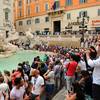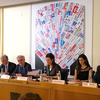Italy in 2017: The Good, the Bad and the Ugly
ROME -- It's easy to decide to make a list of the best and worst of Italy in 2017. The criteria is that the choice of good, bad and ugly (borrowing from the Sergio Leone film of 1966) should depend upon what is likely to bring lasting consequences.
THE GOOD: Topping my personal list of the best of 2017 is the hard work toward preserving Italy's magnificent and unique cultural heritage, unique in the world, but also almost too vast to manage. This year has brought genuine improvements, thanks to private foundations and private citizens, but also -- surprise! -- to the much maligned government, whose Minister for Culture and Tourism is Dario Franceschini, Ferrara-born lawyer.
When he was assigned the combined role culture-tourism, purists decried the duopoly. Beginning in 2014, Franceschini instituted a reform aimed at reinforcing and promoting the Italian heritage. But it has borne fruit, and outsiders have recognized his achievements: he was just awarded with the prestigious Legion d'Honeur by the French government.
The results this closing year show a record number of museum visitors, up by 7 million (18.5%) in three years, and of ticket purchases, up 13.5% over the same period, with profits going to improvements including at Pompeii, where formerly shuttered buildings have been restored and this year reopened. Among his efforts was to promote off-the-beaten-track museums. It worked, and attendance to those lesser known museums outside of Rome, Florence and Venice has soared, including in the regions of Liguria, with museum visitors up by 23%; in Friuli Venezia, 19,2%; and Campania, 14%.
THE BAD: And now, the worst of the year: the failure to address the deeply rooted problem of corruption, which has a link to the country's inefficient, sloppy bureaucracy. As a specialist in the area said to me, "If you are a businessman and you need a contract signed, and it can't get through the bureaucracy, you pay." To whom? As recent arrests of individuals from parties right and left have shown, to the bureaucrats themselves as well as to the kingpins of organized crime.
THE UGLY: One of the worst events of the year was the government's fault: its failure to pass so far the Ius Soli bill that would have granted citizenship to the children of immigrants born in Italy or who had arrived at a very young age and grown up speaking Italian, attending Italian schools and knowing only Italy. Not only did Beppe Grillo's Movimento Cinque Stelle (M5S) desert Parliament on the day when the vote for Ius Soli was to take place, but so did Matteo Renzi's own governing party, the Partito Democratico. The Ius Soli failure will be definitive unless voted by Dec. 29, when Parliament shuts down.
THE GOOD: It is no surprise that pizza is now celebrated by UNESCO as a world heritage treasure. Italians consistently maintain the high level of their cuisine, beginning with raising crops with scientific care and cooking that respects their glorious tradition. What are called "0 kilometer" foodstuffs, grown and sold locally, are still readily available, from artichokes to wines and cheeses made from the milk of the sheep and goats you can see on the hillsides. It is also why the international media, who trek into Italy to interview centennarians, attribute the longevity to healthy diets, as well as to a family-centered world. A loss Dec. 26: innovative chef Gualtiero Marchesi died at age 87.
THE BAD: An upsurge of youth violence is underway with gangs of youngsters 15 years old or so viciously attacking bus drivers and immigrants. Graffiti on Roman buses has also been blamed on a baby gang of kids from 10 to 13 years of age. Save for the crime underworld, this has traditionally been a nation where casual teenage violence was not the norm. Perhaps in 2018 the roots of this new phenomenon will be analyzed.
THE UGLY: Although Rome's gorgeous Mayor Virginia Raggi of the M5S made a stunning appearance in an off-the-shoulder evening gown at the opening night of the opera, Rome itself has grown ugly with rubbish pile-up's, potholes and public transport that is visibly failing. A pitiful sign of the times: the companies that paid to advertise on public buses and trains rare placing fewer ads this year because (1) too many buses are broken down and don't run at all, and (2) when they do, they attract the worst sort of graffiti. Who wants your ad defaced? This income loss means that the money to repair the buses and trains is not arriving.
THE GOOD: Milan, which the Italians call "entrepreneurial humus," is the focal point for business, high fashion and high culture. The cradle of the Italian business culture has no fewer than eight important universities which enjoy international standing. "This city lives upon its business sense, which arose in an organized fashion so many years ago," said Prof. Maurizio Dallocchio of the Bocconi University, speaking at the conference Panorama d'Italia, held in Milan.
THE BAD AND THE GOOD: The ruling Partito Democratico has splintered into at least four grouplets, leaving a drastically weakened center-left. Luckily, ever since being named premier on Dec. 12, 2016, Paolo Gentiloni has shown himself to be as much the gentleman as his name evokes. Together with that other gentlemanly politician, Italy's twelfth President Sergio Mattarella, Gentiloni has held the political country together.










































i-Italy
Facebook
Google+
This work may not be reproduced, in whole or in part, without prior written permission.
Questo lavoro non può essere riprodotto, in tutto o in parte, senza permesso scritto.